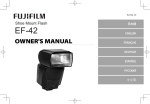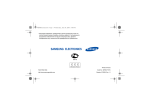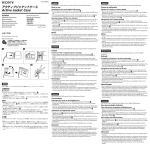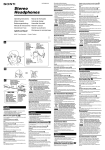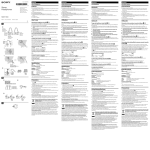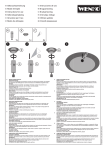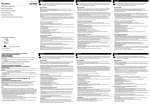Download Sony BC-TRG User's Manual
Transcript
2-673-804-23(1) Battery charger Chargeur de Batterie < Notice for the customers in the countries applying EU Directives > The manufacturer of this product is Sony Corporation, 1-7-1 Konan Minato-ku Tokyo, 108-0075 Japan. The Authorized Representative for EMC and product safety is Sony Deutschland GmbH, Hedelfinger Strasse 61, 70327 Stuttgart, Germany. For any service or guarantee matters please refer to the addresses given in separate service or guarantee documents. WARNING Operating Instructions Troubleshooting Pour charger la batterie When the CHARGE lamp blinks, check through the following chart. Mettez la batterie sur le chargeur pour la recharger. 1 Fixez la batterie (Voir l’illustration A). Alignez le repère de batterie V dans le sens du repère de chargeur V et insérez la batterie dans le sens de la flèche (Voir l’illustration A-1). Après l’avoir bien enfoncée, appuyez légèrement dans le sens de la flèche jusqu’à ce qu’elle s’encliquette (Voir l’illustration A-2). 2 Raccordez le cordon d’alimentation au chargeur puis à une prise secteur (Voir l’illustration B). Le témoin CHARGE (orange) s’allume et la recharge commence. Lorsque le témoin CHARGE s’éteint, la recharge normale est terminée (Recharge normale). Pour une recharge complète, qui permettra d’utiliser la batterie plus longtemps, laissez la batterie en place encore une heure environ (Recharge complète). Remove the battery that is being charged and firmly attach the same battery again. The CHARGE lamp blinks again: Install another battery pack. The CHARGE lamp lights up and does not blink again: If the CHARGE lamp goes out because the charging time has passed, there is no problem. The CHARGE lamp blinks again: The problem is with this unit. The CHARGE lamp lights up and does not blink again: If the CHARGE lamp goes out because the charging time has passed, the problem is with the battery pack first installed. To reduce fire or shock hazard, do not expose the unit to rain or moisture. Mode d’emploi Manual de instrucciones To avoid electrical shock, do not open the cabinet. Refer servicing to qualified personnel only. Инструкция по зксплуатации Notes on Use This unit does not have dust-proof, splash-proof or waterproof specifications. Precautions on Use BC-TRG © 2006 Sony Corporation Printed in Japan •The BC-TRG battery charger can only be used to charge a “InfoLITHIUM” battery (type G) and lithium ion type battery (type G). •Designed for use with compatible Sony batteries. •This unit cannot be used to charge a nickel cadmium type or nickel metal hydride type battery pack. •“InfoLITHIUM” is a trademark of Sony corporation. •Le chargeur de batterie BC-TRG ne peut être utilisé que pour charger une batterie de type « InfoLITHIUM » (type G) et une batterie de type lithium-ion (type G). •Conçu pour une utilisation avec des batteries Sony compatibles. •Ce chargeur ne peut pas être utilisé pour charger les batteries au nickel-cadmium ou aux hydrures métalliques de nickel. •« InfoLITHIUM » est une marque de Sony corporation. •El cargador de baterías BC-TRG solamente podrá utilizarse para cargar una batería “InfoLITHIUM” (tipo G) y de tipo iones de litio (tipo G). •Diseñado para utilizarse con baterías Sony compatibles. •Esta unidad no podrá utilizarse para cargar baterías de tipo níquel-cadmio ni baterías de tipo hidruro metálico de níquel. •“InfoLITHIUM” es una marca comercial de Sony corporation. A1 CHARGE lamp Témoin CHARGE Lámpara indicadora de carga (CHARGE) CHARGER V mark Repère CHARGER V Marca V del CHARGER • Connect the battery charger to an available wall socket. Even though the CHARGE lamp of this battery charger is off, it is not disconnected from the power source. If any trouble occurs while the unit is in use, unplug the battery charger from the wall socket to disconnect the power source. • Do not use the battery charger placed in a narrow space, such as between a wall and furniture. • This unit is not disconnected from the AC power source (mains) as long as it is connected to the wall outlet, even if this unit itself has been turned off. • This unit cannot be used to charge a nickel cadmium type, or nickel metal hydride type battery pack. • Attach the battery pack to the unit firmly when you charge the battery pack. • The battery terminal may be damaged if the battery pack is not attached correctly. • To protect the battery pack, remove the battery pack from the unit as soon as the charging is completed. • Do not apply mechanical shock or drop the unit. • Keep the unit away from a TV or AM receivers. In particular, noise from the device may enter a TV or radio if it is placed nearby. • Unplug the unit from the wall socket if it will not be used for extended period of time. To disconnect the mains lead, pull it out by the plug. Never pull the mains lead itself. • Be sure that nothing metallic comes into contact with the metal parts of the unit. If it does, a short may occur and the unit may be damaged. • The battery pack and battery charger can become warm during or immediately after recharging. Where not to place this unit Regardless of whether this unit is in use or in storage, do not place it in any of the following locations. Doing so may lead to breakdown. • Placing this unit in locations subject to the direct sunlight such as on dashboards or near heating apparatus may cause this unit to deform or malfunction. • Locations of excessive vibration • Locations with strong electromagnetism or radiant rays • Locations with excessive sand In locations such as the seashore and other sandy areas or where dust clouds occur, protect the unit from sand and dust. There is a risk of breakdown. Maintenance • Wipe the unit with a soft dry cloth when it is dirty. • If the unit is very dirty, wipe it using a cloth with a little neutral solvent added, and then wipe it dry again. • Do not use thinners, benzine, alcohol, etc., as they will damage the surface of the unit. • When you use chemical cleaning clothes, refer to their instruction manual. • Using a volatile solvent like an insecticide, or keeping the unit touching a rubber or vinyl plastic product for a long time may cause a deterioration or damage to the unit. To Charge the Battery Pack Battery pack Batterie Baterí BATTERY V mark Repère BATTERY V Marca V de la BATTERY AC input terminal Borne d’entrée CA Terminal de entrada de ca 2 Charging by attaching the battery pack to this unit. 1 Attach the battery pack (See Illustration A). Align the battery V mark in the direction of the charger V mark and insert it in the direction of the arrow (See Illustration A-1). After inserting it as far as it will go, press lightly in the direction of the arrow until it clicks (See Illustration A-2). 2 Connect the mains lead to the battery charger and then to a wall socket (See Illustration B). The CHARGE lamp (orange) will light up and charging will begin. When the CHARGE lamp goes out, normal charging is completed (Normal charge). For a full charge, which allows you to use the battery longer than usual, leave the battery pack in place for approximately another one hour (Full charge). To remove the battery pack Lift the battery pack up and remove it. Charging time The following table shows the charging time for a battery pack that is discharged completely. Battery Pack Full charging time Normal charging time B NP-BG1/NP-FG1 150 (90) • Approximate number of minutes to fully charge an empty battery pack (Full charging time). • Numbers in parentheses indicate the time to charge normally (Normal charging time). • To ascertain the battery life, refer to the instruction manual of the digital still camera that you use. • The charging time may differ depending on the condition of the battery pack or the temperature of the environment. Charging temperature NOTICE FOR THE CUSTOMERS IN THE UNITED KINGDOM A moulded plug complying with BS 1363 is fitted to this equipment for your safety and convenience. Should the fuse in the plug supplied need to be replaced, a fuse of the same rating as the supplied one and approved by ASTA or BSI to BS1362 (i.e., marked with or mark) must be used. If the plug supplied with this equipment has a detachable fuse cover, be sure to attach the fuse cover after you change the fuse. Never use the plug without the fuse cover. If you should lose the fuse cover, please contact your nearest Sony service station. English Disposal of Old Electrical & Electronic Equipment (Applicable in the European Union and other European countries with separate collection systems) This symbol on the product or on its packaging indicates that this product shall not be treated as household waste. Instead it shall be handed over to the applicable collection point for the recycling of electrical and electronic equipment. By ensuring this product is disposed of correctly, you will help prevent potential negative consequences for the environment and human health, which could otherwise be caused by inappropriate waste handling of this product. The recycling of materials will help to conserve natural resources. For more detailed information about recycling of this product, please contact your local Civic Office, your household waste disposal service or the shop where you purchased the product. The temperature range for charging is 0 °C to 40 °C (32 °F to 104 °F). However, to provide maximum battery efficiency, the recommended temperature range when charging is 10 °C to 30 °C (50 °F to 86 °F). To use the battery pack quickly You can remove the battery pack from the unit and use it even though the charging is not completed yet. However, the time that the battery pack can be used differs depending on the charging time. Notes • Check if the battery pack is attached to this unit firmly when the CHARGE lamp does not light. • When a fully charged battery pack is installed, the CHARGE lamp will light up once, then go out. • When charging a battery pack which has not been used for a long time, it may take longer than usual to charge. Do not connect the battery charger to a voltage adaptor (travel converter) for overseas travel. This may result in overheating or other malfunction. Pour enlever la batterie Please contact your nearest Sony dealer in connection with the product with the problem. Specifications Input rating Output rating Operating temperature Storage temperature Dimensions Mass Included items 100 V - 240 V AC 50/60 Hz 8 W 0.13 A Battery charge terminal: 4.2 V DC 1.5 A 0 °C to 40 °C (32 °F to 104 °F) –20 °C to +60 °C (-4 °F to +140 °F) Approx. 48 × 36 × 81 mm (w/h/d) (1 15/16 × 1 7/16 × 3 1/4 inches) Approx. 85 g (3 oz.) Battery charger (BC-TRG) ......... (1) AC Power cord (mains lead) .... (1) Set of printed documentation Soulevez la batterie et enlevez-la. Temps de recharge Le tableau suivant indique le temps de recharge quand la batterie est complètement déchargée. Batterie rechargeable Temps de recharge complète Temps de recharge normale NP-BG1/NP-FG1 150 (90) • Temps de recharge approximatif en minutes pour recharger complètement une batterie vide (Temps de recharge complète). • Les chiffres entre parenthèses indiquent le temps normal (Temps de recharge normale). • Voir le mode d’emploi de l’appareil photo numérique utilisé pour vérifier l’autonomie de la batterie. • Le temps de recharge varie selon l’état de la batterie et la température ambiante. Design and specifications are subject to change without notice. Température de recharge Français La batterie peut être rechargée à une température comprise entre 0 °C et 40 °C (32 °F et 104 °F). Cependant, pour que son efficacité soit optimale, il est conseillé de la recharger entre 10 °C et 30 °C (50 °F et 86 °F). Traitement des appareils électriques et électroniques en fin de vie (Applicable dans les pays de l’Union Européenne et aux autres pays européens disposant de systèmes de collecte sélective) Ce symbole, apposé sur le produit ou sur son emballage, indique que ce produit ne doit pas être traité avec les déchets ménagers. Il doit être remis à un point de collecte approprié pour le recyclage des équipements électriques et électroniques. En s’assurant que ce produit est bien mis au rebut de manière appropriée, vous aiderez à prévenir les conséquences négatives potentielles pour l’environnement et la santé humaine. Le recyclage des matériaux aidera à préserver les ressources naturelles. Pour toute information supplémentaire au sujet du recyclage de ce produit, vous pouvez contacter votre municipalité, votre déchetterie ou le magasin où vous avez acheté le produit. < Avis aux consommateurs des pays appliquant les Directives UE > Le fabricant de ce produit est Sony Corporation, 1-7-1 Konan Minato-ku Tokyo, 108-0075 Japon. Le représentant agréé pour la compatibilité électromagnétique et la sécurité du produit est Sony Deutschland GmbH, Hedelfinger Strasse 61, 70327 Stuttgart, Allemagne. Pour toute question relative à la garantie ou aux réparations, reportez-vous à l’adresse que vous trouverez dans les documents ci-joints, relatifs à la garantie et aux réparations. AVERTISSEMENT Afin de réduire les risques d’incendie ou de décharge électrique, n’exposez pas cet appareil à la pluie ou à l’humidité. Afin d’écarter tout risque d’électrocution, garder le boîtier fermé. Ne confier l’entretien de l’appareil qu’à un technicien qualifié. Remarques sur l’utilisation Pour utiliser rapidement la batterie Vous pouvez utiliser la batterie même si elle n’a pas été complètement chargée. Son autonomie sera toutefois moins grande. Remarques • Vérifiez si la batterie est bien fixée au chargeur si lorsque témoin CHARGE ne s’allume pas. • Quand vous insérez une batterie pleine dans le chargeur, le témoin CHARGE s’allume une fois puis s’éteint. • Il faudra probablement plus de temps que d’habitude pour recharger une batterie qui n’a pas été utilisée depuis longtemps. Si vous voyagez à l’étranger, n’utilisez pas le chargeur avec un adaptateur de tension (adaptateur portatif). Cela peut provoquer une surchauffe et des dysfonctionnements. Dépannage Lorsque le témoin CHARGE clignote, consultez le tableau suivant. Retirez la batterie chargée et remettez-la fermement en place. Si le témoin CHARGE clignote encore : Installez une autre batterie rechargeable. Si le témoin CHARGE clignote de nouveau : Le problème vient de l’appareil. Spécifications Précautions d’emploi Tension d’entrée Endroits à éviter Qu’il soit en service ou rangé, le chargeur ne devra pas être posé dans les types d’endroits suivants au risque d’être endommagé. • N’exposez pas cet appareil à la lumière directe du soleil, comme sur le tableau de bord d’une voiture ou à la chaleur d’un appareil de chauffage, car il pourrait être déformé ou ne plus fonctionner. • Endroits soumis à de fortes vibrations • Endroits exposés à un électromagnétisme ou à des radiations puissantes • Environnement très sablonneux En bord de mer et dans les autres types de régions sableuses ou soumises à des nuages de poussière protégez le chargeur du sable et de la poussière. Il risquerait d’être endommagé. Entretien • Essuyez l’appareil avec un chiffon sec et doux lorsqu’il est sale. • Lorsqu’il est très sale, essuyez-le avec un chiffon imprégné d’un peu de solvant neutre, et séchez-le bien. • Ne pas utiliser de diluants, d’essence, d’alcool, etc. car ils peuvent endommager la surface de l’appareil. • Si vous utilisez des lingettes de nettoyage, lisez attentivement le mode d'emploi. • L’appareil peut se décolorer ou être endommagé au contact de solvants volatils, comme les insecticides, ou s’il reste longtemps au contact de produits en caoutchouc ou en vinyle. Si le témoin CHARGE s’allume mais ne clignote pas de nouveau : Si le témoin CHARGE s’éteint parce que la recharge est terminée, le problème vient de la première batterie rechargeable installée. Veuillez contacter votre revendeur Sony et lui apporter l’appareil qui ne fonctionne pas. Cet appareil n’est pas étanche à la poussière, aux projections d’eau et à l’eau en général. • Raccordez le chargeur de batterie à une prise secteur. Même lorsque le témoin CHARGE est éteint, le chargeur n’est pas isolé de la source d’alimentation. En cas de problème, débranchez immédiatement le cordon d’alimentation de la prise murale pour isoler le chargeur de la source d’alimentation. • N’utilisez pas le chargeur à un endroit exigu, par exemple entre un mur et un meuble. • Cet appareil n’est pas déconnecté de la source d’alimentation tant qu’il est branché à la prise murale, même s’il a été mis hors tension. • Ce chargeur ne peut pas être utilisé pour charger les batteries au nickel-cadmium ou aux hydrures métalliques de nickel. • Fixez correctement la batterie rechargeable sur l’appareil lorsque vous la rechargez. • La borne de la batterie peut être endommagée si la batterie n’est pas fixée correctement. • Pour protéger la batterie, retirez-la de l’appareil dès que la recharge est terminée. • Ne pas appliquer de chocs mécaniques au chargeur ou le le laisser tomber. • Ne pas laisser le chargeur à proximité d’un téléviseur ou d’un récepteur AM. Il peut parasiter la réception télévisée ou radio s’il est placé trop près. • Débranchez l’appareil de la prise murale s’il ne doit pas être utilisé pendant longtemps. Pour débrancher le cordon, tirez sur la fiche. Ne tirez jamais sur le cordon proprement dit. • Evitez que des objets métalliques ne touchent les parties métalliques du chargeur. Un court-circuit pourrait se produire et endommager l’appareil. • La batterie et son chargeur risquent de chauffer pendant ou immédiatement après la recharge. Si le témoin CHARGE s’allume mais ne clignote pas de nouveau : Si le témoin CHARGE s’éteint parce que la recharge est terminée, il n’y a aucun problème. Secteur 100 V - 240 V 50/60 Hz 8 W 0,13 A Tension de sortie Borne de recharge de la batterie : 4,2 V CC 1,5 A Température de fonctionnement 0 °C à 40 °C (32 °F à 104 °F) Température d’entreposage –20 °C à +60 °C (-4 °F à +140 °F) Dimensions environ 48 × 36 × 81 mm (l/h/p) (1 15/16 × 1 7/16 × 3 1/4 pouces) Poids environ 85 g (3 oz) Articles inclus Chargeur de batterie (BC-TRG) .. (1) Cordon d’alimentation secteur ... (1) Jeu de documents imprimés La conception et les spécifications peuvent être modifiées sans préavis. Español Tratamiento de los equipos eléctricos y electrónicos al final de su vida útil (aplicable en la Unión Europea y en países europeos con sistemas de recogida selectiva de residuos) Este símbolo en el equipo o el embalaje indica que el presente producto no puede ser tratado como residuos domésticos normales, sino que debe entregarse en el correspondiente punto de recogida de equipos eléctricos y electrónicos. Al asegurarse de que este producto se desecha correctamente, Ud. ayuda a prevenir las consecuencias negativas para el medio ambiente y la salud humana que podrían derivarse de la incorrecta manipulación en el momento de deshacerse de este producto. El reciclaje de materiales ayuda a conservar los recursos naturales. Para recibir información detallada sobre el reciclaje de este producto, póngase en contacto con el ayuntamiento, el punto de recogida más cercano o el establecimiento donde ha adquirido el producto. < Aviso para los clientes de países en los que se aplican las directivas de la UE > El fabricante de este producto es Sony Corporation, 1-7-1 Konan Minato-ku Tokyo, 108-0075, Japón. El representante autorizado en lo referente al cumplimiento de la directiva EMC y a la seguridad de los productos es Sony Deutschland GmbH, Hedelfinger Strasse 61, 70327 Stuttgart, Alemania. Para resolver cualquier asunto relacionado con el soporte técnico o la garantía, consulte las direcciones que se indican en los documentos de soporte técnico y garantía suministrados por separado. ADVERTENCIA Para reducir el riesgo de incendio o descarga eléctrica, no exponga la unidad a la lluvia ni a la humedad. Para evitar descargas eléctricas, no abra la caja. En caso de avería, solicite los servicios de personal cualificado. Nombre del producto: Cargador de baterías Modelo: BC-TRG Nota sobre la utilización Esta unidad no posee especificaciones de protección contra el polvo, las salpicaduras, ni el agua. Precauciones sobre la utilización • Conecte el cargador de baterías a una toma de corriente disponible. Incluso aunque la lámpara CHARGE de este cargador de baterías esté apagada, éste no estará desconectado de la fuente de alimentación. Si ocurre algún problema mientras esté utilizando la unidad, desenchufe el cargador de baterías de la toma de corriente de la red para desconectar la fuente de alimentación. • No utilice el cargador de baterías en un espacio estrecho, como entre una pared y un mueble. • Esta unidad no se desconectará de la fuente de alimentación de ca (red principal) mientras esté conectada a la toma de pared, aunque el propio equipo se haya desconectado. • Esta unidad no podrá utilizarse para cargar baterías de tipo níquel-cadmio, ni baterías de tipo de hidruro metálico de níquel. • Para cargar la batería fíjela firmemente. • Los terminales de la batería podrían dañarse si la batería no estuviese correctamente fijada. • Para proteger la batería, extráigala de la unidad en cuanto se haya cargado. • No golpee ni deje caer la unidad. • Mantenga la unidad alejada de televisores y receptores de AM. En particular, el ruido de esta unidad podría entrar en un televisor o en una radio si se coloca cerca. • Cuando no vaya a utilizar la unidad durante mucho tiempo, desconéctela del tomacorriente. Para desconectar el cable, tire del enchufe. No tire nunca del propio cable. • Cerciórese de que nada metálico entre en contacto con las partes metálicas de la unidad. En caso contrario podría cortocircuitar y dañar la unidad. • Es posible que la batería y el cargador de baterías se calienten durante la carga o inmediatamente después de la misma. Dónde no colocar esta unidad Independientemente de si va a utilizar o almacenar esta unidad, no la coloque en ninguno de los lugares siguientes. Si no hiciese esto, la unidad podría dañarse. • Si coloca la unidad en lugares sometidos a la luz solar directa, como sobre el panel de instrumentos, o cerca de aparatos de calefacción, es posible que se deforme o funcione mal. • Lugares sometidos a vibración excesiva • Lugares con electromagnetismo o radiación de rayos excesiva • Lugares con arena excesiva En lugares tales como playas u otras zonas arenosas, o donde haya nubes de polvo, proteja la unidad contra la arena y el polvo. Existiría el riesgo de rotura. Mantenimiento • Cuando se ensucie la unidad, frótela con un paño seco y suave. • Si la unidad está muy sucia, frótela utilizando un paño ligeramente humedecido en disolvente, y después séquela. • No utilice diluyentes, bencina, alcohol, etc., ya que podría dañar la superficie de la unidad. • Antes de utilizar paños de limpieza químicos, consulte su manual de instrucciones. • La utilización de disolventes volátiles, como insecticidas, o si deja la unidad en contacto con productos de caucho o de vinilo durante mucho tiempo, podría causar el deterioro o el daño de dicha unidad. Para cargar una batería Cargue la batería fijándola a esta unidad. 1 Fije la batería. (Consulte la ilustración A.) Alinee la marca V de la batería con la marca V del cargador, e insértela en el sentido de la flecha. (Consulte la ilustración A-1.) Después de haberla insertado a fondo, presiónela ligeramente en el sentido de la flecha hasta que chasquee. (Consulte la ilustración A-2.) 2 Conecte el cable de alimentación al cargador de baterías y, a continuación, a una toma de corriente. (Consulte la ilustración B.) La lámpara CHARGE (anaranjada) se encenderá y se iniciará la carga. Cuando se apague la lámpara CHARGE, habrá finalizado la carga normal (Carga normal). Para la carga completa, que le permitirá utilizar la batería durante más tiempo del usual, deje la batería colocada durante aproximadamente una hora más (Carga completa). Para extraer la batería Levante la batería y extráigala. Tiempo de carga En la tabla siguiente se muestra el tiempo de carga para una batería completamente descargada. Batería Tiempo de carga completa Tiempo de carga normal NP-BG1/NP-FG1 150 (90) • Número aproximado de minutos para cargar completamente una batería vacía (Tiempo de carga completa). • El número entre paréntesis indica el tiempo necesario para cargar normalmente una batería (Tiempo de carga normal). • Para prologar la duración útil de la batería, consulte el manual de instrucciones de la cámara digital que vaya a utilizar. • El tiempo de carga puede diferir dependiendo de la condición de la batería o la temperatura ambiental. Temperatura de carga El margen de temperaturas para la carga es de 0 °C a 40 °C Sin embargo, para lograr la máxima eficacia de la batería, el margen de temperaturas recomendado es de 10 °C a 30 °C Para utilizar rápidamente la batería Usted podrá extraer la batería de la unidad y utilizarla aunque no haya terminado de cargarse. Sin embargo, el tiempo que podrá utilizar la batería dependerá del tiempo que la haya cargado. Notas • Compruebe si la batería está firmemente fijada a la unidad cuando la lámpara CHARGE no se encienda. • Si instala una batería completamente cargada, la lámpara CHARGE se encenderá una vez y después se apagará. • Cuando cargue una batería que no haya utilizado durante mucho tiempo, es posible que tarde más tiempo del normal en cargarse. No conecte el cargador de baterías a un adaptador de tensión (convertidor para viajes) para viajes a ultramar. Esto podría resultar en recalentamiento o mal funcionamiento. (Continúa en la página posterior) Русский • Зарядное устройство BC-TRG может использоваться только для зарядки батарейки “InfoLITHIUM” (типа G) и батарейки литиево-ионного типа (типа G). • Предназначена для использования с совместимыми батарейками Sony. • Данное устройство не может использоваться для зарядки батарейного блока никель-кадмиевого или гидрид металла-никелевого типа. • “InfoLITHIUM” является торговой маркой фирмы Sony. • • • • A1 Лампочка CHARGE Батарейный блок Метка V BATTERY V Метка V CHARGER V Разъем ввода переменного тока Поднимите вверх батарейный блок и снимите его. Время зарядки Утилизaция элeктpичecкого и элeктpонного обоpyдовaния (диpeктивa пpимeняeтcя в cтpaнax Eвpоcоюзa и дpyгиx eвpопeйcкиx cтpaнax, гдe дeйcтвyют cиcтeмы paздeльного cбоpa отxодов) Дaнный знaк нa ycтpойcтвe или eго yпaковкe обознaчaeт, что дaнноe ycтpойcтво нeльзя yтилизиpовaть вмecтe c пpочими бытовыми отxодaми. Eго cлeдyeт cдaть в cоотвeтcтвyющий пpиeмный пyнкт пepepaботки элeктpичecкого и элeктpонного обоpyдовaния. Heпpaвильнaя yтилизaция дaнного издeлия можeт пpивecти к потeнциaльно нeгaтивномy влиянию нa окpyжaющyю cpeдy и здоpовьe людeй, поэтомy для пpeдотвpaщeния подобныx поcлeдcтвий нeобxодимо выполнять cпeциaльныe тpeбовaния по yтилизaции этого издeлия. Пepepaботкa дaнныx мaтepиaлов поможeт cоxpaнить пpиpодныe pecypcы. Для полyчeния болee подpобной инфоpмaции о пepepaботкe этого издeлия обpaтитecь в мecтныe оpгaны гоpодcкого yпpaвлeния, cлyжбy cбоpa бытовыx отxодов или в мaгaзин, гдe было пpиобpeтeно издeлиe. < Примечание для покупателей в странах, где действуют директивы ЕС > Производителем данного устройства является корпорация Sony Corporation, 1-7-1 Konan Minato-ku Tokyo, 108-0075 Japan. Уполномоченным представителем по электромагнитной совместимости (EMC) и безопасности изделия является компания Sony Deutschland GmbH, Hedelfinger Strasse 61, 70327 Stuttgart, Germany. По вопросам обслуживания и гарантии обращайтесь по адресам, указанным в соответствующих документах. ПРЕДУПРЕЖДЕНИЕ для уменьшения опасности возгорания или поражения электрическим током не подвергайте аппарат воздействию дождя или влаги. 2 Во избежание поражения электрическим током нельзя открывать корпус. За ремонт устройства следует обращаться только к квалифицированному персоналу. Примечания по пользованию B Настоящий адаптер не изготовляется в защищенном исполнении – пыле-, брызго- или водозащищенном исполнении. Общие указания по пользованию Español (Continuación de la página frontal) Solución de problemas Cuando la lámpara CHARGE parpadee, compruebe la tabla siguiente. Extraiga la batería que se esté cargando y vuelva a fijarla correctamente. La lámpara CHARGE vuelve a parpadear: Instale otra batería. La lámpara CHARGE vuelve a parpadear: El problema está en la unidad. La lámpara CHARGE se enciende y no vuelve a parpadear: Si la lámpara CHARGE se apaga porque ha transcurrido el tiempo de carga, no existirá ningún problema. La lámpara CHARGE se enciende y no vuelve a parpadear: Si la lámpara CHARGE se apaga porque ha transcurrido el tiempo de carga, el problema estará en la batería instalada por primera vez. Con respecto al producto con problemas, póngase en contacto con su proveedor Sony. Especificaciones Entrada nominal ca 100 V - 240 V 50/60 Hz 8 W 0,13 A Salida nominal Terminales de carga de batería: cc 4,2 V 1,5 A Temperatura de funcionamiento 0 °C a 40 °C Temperatura de almacenamiento –20 °C a +60 °C Dimensiones Aprox. 48 × 36 × 81 mm (an/al/prf) Peso Aprox. 85 g Elementos incluidos Cargador de baterías (BC-TRG) ............................. (1) Cable de alimentación de ca ............................................... (1) Juego de documentación impresa El diseño y las especificaciones están sujetos a cambio sin previo aviso. Для снятия батарейного блока • Подсоедините зарядное устройство к доступной штепсельной розетке. Даже если лампочка CHARGE зарядного устройства не горит, он не отключен от сети. При возникновении какого-нибудь затруднения в работе устройства следует отсоединить зарядное устройство от штепсельной розетки для отключения его от сети. • Не следует использовать зарядное устройство в ограниченном пространстве, таком как между стеной и мебелью. • Настоящее устройство не отключается от источника питания переменного тока (сети) даже при выключении его собственно, пока оно не отключится от штепсельной розетки. • Настоящее устройство не может использоваться для зарядки батарейного блока никель-кадмиевого или гидрид металла-никелевого типа. • Установите батарейный блок на устройство надежно при зарядке батарейного блока. • Разъем батареи может быть поврежден при неправильной установке батарейного блока. • Для защиты батарейного блока следует отсоединить батарейный блок от устройства по окончании зарядки. • Не следует подвергнуть устройство механическим ударам или уронить его. • Держите устройство подальше от ТВ или АМ-приемников. Особенно, помехи от устройства могут возникнуть на ТВ или радиоприемнике в результате размещения близко к нему. • Отсоедините устройство от штепсельной розетки, если оно не будет использоваться длительное время. Для отсоединения сетевого шнура надо потянуть его за вилку. Никогда не тяните за сам шнур. • Следите за тем, чтобы никакие металлические предметы не соприкоснулись с металлическими частями устройства. Несоблюдение этого указания может привести к короткому замыканию, и устройство будет повреждено. • Батарейный блок и зарядное устройство могут стать горячими во время зарядки или по окончании зарядки. Места, не подлежащие размещению устройства Независимо от нахождения устройства в работе или в хранении не следует разместить его в приведенных ниже местах. Несоблюдение этого указания может привести к неисправности устройства. • Размещение устройства в месте, где оно подвергается воздействиям непосредственных солнечных излучений, в том числе и на контрольном щитке, или близко от нагневателя может привести к деформации или неполадке устройства. • Места, подвергающиеся чрезмерной вибрации • Места, подвергающиеся воздействиям сильного электромагнетизма или излучений • Места значительной песчанистости В местах, таких как пляж и другие песчаные места или где пылевое облако происходит, надо защитить устройство от песка и пыли. Неисправность в работе устройства может возникнуть. Ниже в таблице показано время зарядки батарейного блока, который полностью разряжен. Батарейный блок Время полной зарядки Время нормальной зарядки NP-BG1/NP-FG1 150 (90) • Приблизительное время в минутах для полной зарядки разряженного полностью батарейного блока (Время полной зарядки). • В скобках показано время для нормальной зарядки (Время нормальной зарядки). • Для проверки оставшегося заряда батарейного блока смотрите руководство по эксплуатации используемой цифровой фотокамеры. • Время зарядки может различаться в зависимости от состояния батарейного блока или температуры окружающей среды. Тепмература окружающей среды при зарядке Зарядку следует выполнить при температуре от 0 °С до 40 °С. Но, для получения максимальной эффективности батареи рекомендуется диапазон температуры от 10 °С до 30 °С. Для использования батарейного блока сразу Вы можете снять батарейный блок с данного устройства и использовать его, даже если зарядка не завершена. Однако, время, на которое батарейный блок может использоваться, различается в зависимости от времени зарядки. • • • • • • • • • • • • Примечания • Проверьте, что батарейный блок прикреплен к данному устройству надежно, в случае, когда лампочка CHARGE не горит. • При установке заряженного полностью батарейного блока лампочка CHARGE раз загорается с последующим погасанием. • При зарядке батарейного блока после нахождения в нерабочем состоянии в долгое время зарядка требует дольше времени, чем при обычной зарядке. Не следует подсоединить зарядное устройство к адаптеру напряжения (туристскому преобразователю напряжения) для заграничной поездки. Несоблюдение этого указания может привести к перегреву или другой неисправности устройства. • • • • • • • • • Неисправности и способы их устранения В случае, когда лампочка CHARGE мигает, выполните проверку по нижеприведенной схеме. 1 V A Снимите заряжающийся батарейный блок, а затем перестановите тот самый батарейный блок надежно. A V A Лампочка CHARGE мигает опять: Установите другой батарейный блок. Лампочка CHARGE загорается и не мигает опять: Если лампочка CHARGE гаснет потому, что исчезло время зарядки, то нет никаких проблем. Лампочка CHARGE мигает опять: Имеется неполадка в данном устройстве. Лампочка CHARGE загорается и не мигает опять: Если лампочка CHARGE гаснет потому, что исчезло время зарядки, то имеется неполадка в батарейном блоке, установленном первый раз. B 2 Обратитесь, пожалуйста, в ваш ближайший дилер Sony в связи с проблемой в устройстве. Технические характеристики Входные номинальные данные 100 В – 240 В перем. тока 50/60 Гц 8 Вт 0,13 A Выходные номинальные данные Разъем зарядки батареи: 4,2 В пост. тока 1,5 А Температура при работе от 0 °С до 40 °С Температура при хранении от –20 °С до +60 °С Габариты Приблиз. 48 × 36 × 81 мм (ш/в/г) Масса Приблиз. 85 г Комплектность поставки Зарядное устройство (BC-TRG) .. (1) Сетевой шнур переменного тока .. (1) Набор напечатанной документации Конструкция и технические характеристики могут быть изменены без уведомления. • • • • • • • Уход за устройством • Следует вытереть устройство мягкой сухой тряпкой при загрязнении. • При значительном загрязнении следует вытереть устройство тряпкой, слегка смоченной нейтральным растворителем, а затем вытереть его сухой тряпкой опять. • Не следует применить разбавитель, бензин, спирт и т.п., поскольку они может повредить поверхность устройства. • При применении химической чистильной тряпки следует смотреть руководство по пользованию к ним. • Применение летучего растворителя, такого как средство от насекомых, или долговременное оставление устройства в контакте с резиновым или винипластовым изделием может вызвать ухудшение качества или повреждение устройства. Для зарядки батарейного блока Зарядка батарейного блока выполняется при установке его на настоящем устройстве. 1 Установите батарейный блок. (См. рис. A.) Выровните метку V батарейки в направлении метки V зарядного устройства и вставьте батарейный блок в направлении стрелки. (См. рис. A-1.) Вставив его до отказа, слегка нажмите на его в направлении стрелки до щелчка. (См. рис. A-2.) 2 Подсоедините сетевой шнур к зарядному устройству, а затем к штепсельной розетке. (См. рис. B.) Лампочка CHARGE (в красном цвете) загорается и зарядка начинается. При погасании лампочки CHARGE нормальная зарядка завершена (Нормальная зарядка). Для полной зарядки, которая позволяет использовать батарею дольше, чем в обычном случае, оставьте батарейный блок на месте далее около одного часа (Полная зарядка). – × + ×
This document in other languages
- français: Sony BC-TRG
- español: Sony BC-TRG
- русский: Sony BC-TRG


